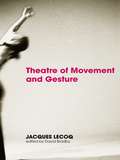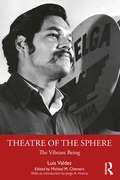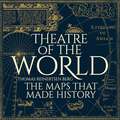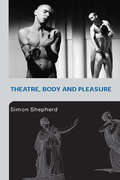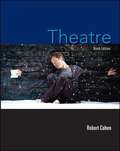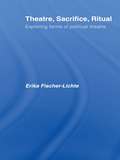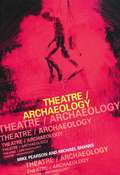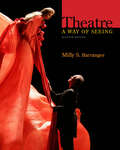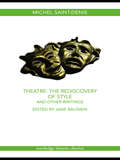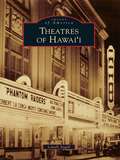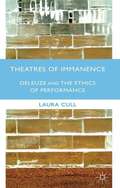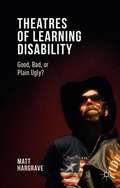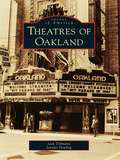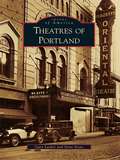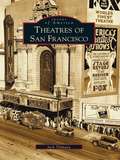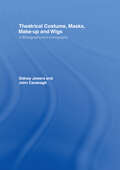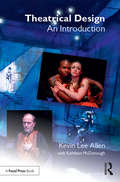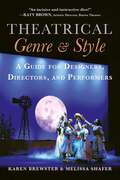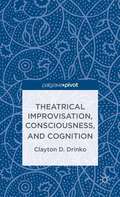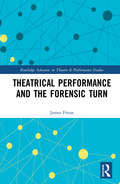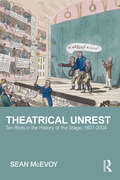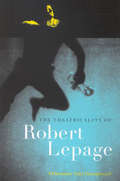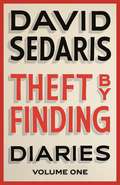- Table View
- List View
Theatre of Movement and Gesture
by Jacques LecoqPublished in France in 1987, this is the book in which Lecoq first set out his philosophy of human movement, and the way it takes expressive form in a wide range of different performance traditions. He traces the history of pantomime, sets out his definition of the components of the art of mime, and discusses the explosion of physical theatre in the second half of the twentieth century. Interviews with major theatre practitioners Ariane Mnouchkine and Jean-Louis Barrault by Jean Perret, together with chapters by Perret on Étienne Decroux and Marcel Marceau, fill out the historical material written by Lecoq, and a final section by Alain Gautré celebrates the many physical theatre practitioners working in the 1980s.
Theatre of the Sphere: The Vibrant Being
by Luis ValdezTheatre of the Sphere is Luis Valdez’s exploration of the principles that underlie his innovations as a playwright, teacher, and theatrical innovator. He discusses the unique aesthetic, more than five decades in the making, that defines the work of his group El Teatro Campesino—from shows staged on the backs of flatbed trucks by the participants in the Delano Grape Strike of the 1960s to international megahits like Zoot Suit. Opening with a history of El Teatro Campesino, rich with Valdez’s insights and remembrances, the book’s first part provides context for the development of the Theatre of the Sphere acting method. The second part delivers the conceptual framework for Valdez’s acting theory and practice, situating it in Mayan mathematics and metaphysics. The third part of the book applies this methodology to describe the "viente pasos," the 20-element exercise sequence that comprises the core practice of El Teatro Campesino—strengthening the body, balance, precision, and flexibility but also leadership, collaboration, observation, vulnerability, trust, and expression of passion; of consciousness of time, place, self, community, language, and belief; of honour, faith, morality, and commitment. The book concludes with the full text of Valdez’s poem, "El Buen Actor/El Mal Actor," and a comprehensive bibliography for further study. This is a vital and indispensable text for today’s actor, as well as scholars and students of contemporary theatre, American and Chicano performance, and the process of theatre-making, actor training, and community performance.
Theatre of the World: The History of Maps and the Men and Women Who Made Them
by Thomas Reinertsen Berg'Visually stunning...it's gone straight to the top of my Christmas present list.' The Bookseller'I remember how well I liked to turn the pages of my childhood atlas and travel the world to find out where countries and cities were. But there was never anything about why the maps were created - or who drew them. Theatre of the World was my big chance to tell the stories of all those men and women map makers whose amazing work deserves to be celebrated.' Thomas Reinertsen BergBeautifully written and rich in detail, Theatre of the World reignites our curiosity with the world both ancient and modern. Before you could just put finger to phone to scroll Google Maps, in advance of the era of digital mapping and globes, maps were being constructed from the ideas and questions of pioneering individuals.From visionary geographers to heroic explorers, from the mysterious symbols of the Stone Age to the familiar navigation of Google Earth, Thomas Reinertsen Berg examines the fascinating concepts of science and worldview, of art and technology, power and ambitions, practical needs and distant dreams of the unknown.(P)2018 Hodder & Stoughton Limited
Theatre, Body and Pleasure
by Simon ShepherdBreaking new ground in the study of performance theory, this maverick and powerful project from renowned Renaissance scholar and queer theorist Simon Shepherd presents a unique take on theory and the physical reality of theatre. Examining a range of material, Theatre, Body, Pleasure addresses a significant gap in the literary and drama studies arenas and explores the interplay of bodily value, the art of bodies and the physical responses to that art. It explains first how the body makes meaning and carries value. Then it describes the relationships between time and space and body. The book’s features include: * large historical range, from medieval to postmodern * case studies offering close readings of written texts * examples of how to ‘read for the body’, exploring written text as a ‘discipline’ of the body * breadth of cultural reference, from stage plays through to dance culture * a range of theoretical approaches, including dance analysis and phenomenology Writing in accessible prose, Shepherd introduces new ways of analyzing dramatic text and has produced a book which is part theatre history, part dramatic criticism and part theatrical tour de force. Students of drama, theatre and performance studies and cultural studies will find this an absolute must read.
Theatre, Ninth Edition
by Robert CohenThis lively introduction to theatre offers equal measures of appreciation of theatrical arts, history of performance, and descriptions of the collaborative theatrical crafts. The author’s enthusiasm for and knowledge of the current theatre, highlighted by contemporary production shots from around the world, put the students in the front row. The text includes extensive excerpts from seven plays: Prometheus Bound, Oedipus Tyrannos, The York Cycle, Romeo and Juliet, The Bourgeois Gentleman, The Three Sisters, and Happy Days, as well as shorter excerpts from The Rover and A Doll's House.
Theatre, Sacrifice, Ritual: Exploring Forms of Political Theatre
by Erika Fischer-LichteIn this fascinating volume, acclaimed theatre historian Erika Fischer-Lichte reflects on the role and meaning accorded to the theme of sacrifice in Western cultures as mirrored in particular fusions of theatre and ritual. Theatre, Sacrifice, Ritual presents a radical re-definition of ritual theatre through analysis of performances as diverse as: Max Reinhardt's new people's theatre the mass spectacles of post-revolutionary Russia American Zionist pageants the Olympic Games. In offering both a performative and a semiotic analysis of such performances, Fischer-Lichte expertly demonstrates how theatre and ritual are fused in order to tackle the problem of community-building in societies characterised by loss of solidarity and disintegration, and exposes the provocative connection between the utopian visions of community they suggest, and the notion of sacrifice. This innovative study of twentieth-century performative culture boldly examines the complexities of political theatre, propaganda and manipulation of the masses, and offers a revolutionary approach to the study of theatre and performance history.
Theatre/Archaeology: An Imperfect Archaeology
by Michael Shanks Mike PearsonTheatre/Archaeology is a provocative challenge to disciplinary practice and intellectual boundaries. It brings together radical proposals in both archaeological and performance theory to generate a startlingly original and intriguing methodological framework.
Theatre: A Way of Seeing
by Milly S. BarrangerConsistently praised as "streamlined" and "clear and student friendly," THEATRE: A WAY OF SEEING offers the beginning theatre student an exciting, full-color introduction to all aspects of theatre. It presents the experience of theatre, who sees it, what is seen, and where and how it is seen largely from the viewpoint of audiences exposed to a complex, living art that involves people, spaces, plays, designs, staging, forms, language, and productions. The book includes the appropriate coverage of the history, diversity, and most critical moments in theatre in a way that encourages students to experience theatre as "a performing art and humanistic event."
Theatre: The Rediscovery of Style and Other Writings
by Michel Saint-DenisMichel Saint-Denis was one of twentieth century theatre’s most influential directors and theorists. This book combines his seminal Theatre: The Rediscovery of Style with material from Training for the Theatre, newly edited to create a work which moves seamlessly from theory to practice. Theatre: The Rediscovery of Style collects five of Saint Denis’ key lectures, given during his time in America, and perfectly encompasses his synergy of classical theatre and modern realism Training for the Theatre is a key practical resource for actors, directors and teachers alike. It covers crucial areas such as understanding a play’s context, training schedules, improvisation and dealing with stage space, as well as a section on Saint-Denis’ use of masks in actor training Theatre: The Rediscovery of Style and Other Writings benefits from Jane Baldwin’s new biographical introduction and annotations, that put Saint-Denis into context for a contemporary audience. It brings a wealth of inspirational material both to the rehearsal space and the classroom.
Theatres of Hawai'i
by Lowell AngellFamous for its lush beauty and inviting beaches, Hawai'i also boasts a rich theatrical history dating back to the mid-19th century and spanning its years as a kingdom, U.S. territory, and a state. Its warm, tropical climate and social, cultural, and ethnic diversity contributed to the variety of theatres unique to the islands--from simple, rural plantation theatres on the neighbor islands, to neighborhood movie houses in exotic styles, to an incomparable tropical moderne jewel near the beach at Waikiki. Most of these theatres are now just a memory, except for those few saved by dedicated individuals and restored for another life. This book celebrates the rich history of these theatrical venues through rare archival photographs and little-known details.
Theatres of Immanence
by Laura CullTheatres of Immanence: Deleuze and the Ethics of Performance, now available in paperback, is the first monograph to provide an in-depth study of the implications of Gilles Deleuze's philosophy for theatre and performance. Engaging with a wide range of interdisciplinary practitioners including Goat Island, Butoh, Artaud, John Cage, the Living Theatre, Robert Wilson and Allan Kaprow, as well as with the philosophies of Deleuze and Guattari, Henri Bergson and Fran#65533;ois Laruelle, the book conceives performance as a way of thinking 'immanence': the open and endlessly creative whole of which all things are a part. Theatres of Immanence builds upon Deleuze's emphasis on immanence, affect, change and movement to provide new approaches to five key topics in theatre and performance: 1) authorship and collaboration, 2) voice and language, 3) animals in performance, 4) audience participation and 5) time or duration. The book provides an accessible introduction to Deleuze's ideas and draws attention to the ethical dimensions of performance, asking: 'what good is theatre, and particularly immanent theatre, anyway?
Theatres of Learning Disability
by Matt HargraveThis is the first scholarly book to focus exclusively on theatre and learning disability as theatre – rather than advocacy or therapy. Matt Hargrave provocatively realigns many of the (hitherto unvoiced) assumptions that underpin such practices, and opens up a new set of critical questions. Stemming from a close engagement with the work of several very different theatre companies – including Mind the Gap (UK); Back to Back (Australia) - and unique solo artists such as Jez Colborne, this book shifts the emphasis from questions of social benefit towards a genuine engagement with aesthetic judgement. Hargrave examines the rich variety of contemporary theatrical practices in this field and spans a wide range of forms such as site specific, naturalistic and autobiographical performance. The book examines ways in which the learning disabled performer might be read on stage, and the ways in which s/he might disturb assumptions, not least about what acting or artistic authorship is. This is an important and timely study for all upper-level theatre and performance students and scholars alike, as well as a provocative contribution to debates within disability studies.
Theatres of Oakland
by Jack Tillmany Jennifer DowlingOakland has a rich theatre history, from the amusements of a gas-lit downtown light opera and vaudeville stage in the 1870s to the ornate cinematic escape portals of the Great Depression. Dozens of neighborhood theatres, once the site of family outings and first dates, remain cherished memories in the lives of Oaklanders. The city can still boast three fabulous movie palaces from the golden age of cinema: the incomparable art deco Paramount, which now offers live performances and films; the stately Grand Lake gracing the sinuous shores of Lake Merritt; and the magnificently eccentric Fox Oakland, with its imposing Hindu gods flanking the stage. The Paramount and Grand Lake still stir the heartstrings of patrons with showings preceded by interludes on their mighty Wurlitzer organs.
Theatres of Portland
by Steve Stone Gary LacherPortland's theatre history is marked by early enthusiasm and exceptionally vigorous growth. With the Pacific Northwest's often rainy weather, people sought refuge in movie entertainment, and the city eventually grew to have more theatre seats per capita than similar-sized cities in the United States. Beginning with short cinema segments at vaudeville houses downtown, Portland movie theatres came into their own swiftly and ambitiously. By 1915, there were over 70 individual theatres showing films both downtown and in neighborhoods throughout the city. By the 1920s, larger theatres were being built, including substantial neighborhood palaces such as the Bagdad, Hollywood, and Oriental. Meanwhile, downtown provided the Broadway, Portland, and Orpheum, to name a few. This volume contains an overview of Portland's theatre history through rare and newly discovered historical photographs of those memorable places of entertainment.
Theatres of San Francisco
by Jack TillmanyYou read the sad stories in the papers: another ornate, 1920s, single-screen theatre closes, to be demolished and replaced by a strip mall. That's progress, and in this 20-screen multiplex world, it's happening more and more. Only a handful of the 100 or so neighborhood theatres that once graced these streets are left in San Francisco, but they live on in the photographs featured in this book. The heyday of such venues as the Clay, Noe, Metro, New Mission, Alexandria, Coronet, Fox, Uptown, Coliseum, Surf, El Rey, and Royal was a time when San Franciscans thronged to the movies and vaudeville shows, dressed to the hilt, to see and be seen in majestic art deco palaces. Unfortunately, this era has passed into history despite the dedicated efforts of many neighborhood preservation groups.
Theatrical Costume, Masks, Make-Up and Wigs: A Bibliography and Iconography (Motley Bibliographies Ser. #Vol. 4)
by Sidney Jackson JowersThis is the first bibliography in its field, based on first-hand collations of the actual articles. International in scope, it includes publications found in public theatre libraries and archives of Barcelona, Berlin, Brussels, Budapest, Florence, London, Milan, New York and Paris amongst others. Over 3500 detailed entries on separately published sources such as books, sales and exhibition catalogues and pamphlets provide an indispensible guide for theatre students, practitioners and historians. Indices cover designers, productions, actors and performers. The iconography provides an indexed record of over 6000 printed plates of performers in role, illustrating performance costume from the 18th to 20th century.
Theatrical Design: An Introduction
by Kevin Lee AllenA theatrical designer must address two questions when designing a production: What is the play about and what is the play like? To find the metaphor within a play is to unlock inspired and unique design concepts. Theatrical Design: An Introduction is about how to find the design idea for a production and what to do with that idea once identified. This book emphasizes script analysis and interpretation specifically for designers: how to release meaning and design inspiration from lines and characterization in a script. It then explains the artistic elements and principles of design—the skills necessary to create the design visualized. Concepts are illustrated with examples from theatre, film, art, architecture, and fashion that explore professional and historic use of conceptualization and metaphor. Theatrical Design: An Introduction imparts the tools designers need to innovate off the page.
Theatrical Genre & Style: A Guide for Designers, Directors, and Performers
by Melissa Shafer Karen BrewsterA one-of-a-kind guide about style and genre for theatre artisans.Theatrical Genre & Style will appeal to all theatre makers—those in performance as well as design—students, amateurs, and professionals. Traditionally, theatre practitioners receive information about style and genre from sources composed primarily for studio artisans and not theatre artisans. These books are helpful but ultimately fall short because they do not specifically apply the use of style to theatre art and practice. Theatrical Genre & Style gives theatre artists a guidebook to style and genre that is specific and tailored to their needs. Theatrical Genre & Style defines genre and style (and the differences between them), gives relatable examples with helpful exercises, clearly explains the distinctions between artistic style, period style, and literary style, and helps readers understand how to identify, research, and utilize appropriate artistic styles for theatrical productions. Theatrical genres are listed, thoroughly explained, and examples and exercises given that are designed to elucidate. The ways theatrical scenery, costumes, lighting, sound, multi-media, acting, directing, and movement can work together to successfully utilize style is addressed in this text.Theatrical Genre & Style serves as a companion to authors Karen Brewster and Melissa Shafer's Fundamentals of Theatrical Design: A Guide to the Basics of Scenic, Costume, and Lighting Design. The two books complement one another in content, size, scope, purpose, and target audience.
Theatrical Improvisation, Consciousness, and Cognition
by Clayton D. DrinkoImprovisation teachers have long known that the human mind could be trained to be effortlessly spontaneous and intuitive. Drinko explores what these improvisation teachers knew about improvisation's effects on consciousness and cognition and compares these theories to current findings in cognitive neuroscience, psychology, and philosophy.
Theatrical Performance and the Forensic Turn: Naked Truth (Routledge Advances in Theatre & Performance Studies)
by James FriezeContemporary theatre, like so much of contemporary life, is obsessed with the ways of which information is detected, packaged and circulated. Running through forms as diverse as neo-naturalistic playwriting, intimately immersive theatre, verbatim drama, intermedial performance, and musical theatre, a common thread can be observed: theatre-makers have moved away from assertions of what is true and focussed on questions about how truth is framed. Commentators in various disciplines, including education, fine art, journalism, medicine, cultural studies, and law, have identified a ‘forensic turn’ in culture. The crucial role played by theatrical and performative techniques in fuelling this forensic turn has frequently been mentioned but never examined in detail. Political and poetic, Theatrical Performance and the Forensic Turn is the first account of the relationship between theatrical and forensic aesthetics. Exploring a rich variety of works that interrogate and resist the forensic turn, this is a must-read not only for scholars of theatre and performance but also of culture across the arts, sciences and social sciences.
Theatrical Speech Acts: Politics, Translations, Embodiments
by Erika Fischer-Lichte Torsten Jost Saskya Iris JainTheatrical Speech Acts: Performing Language explores the significance and impact of words in performance, probing how language functions in theatrical scenarios, what it can achieve under particular conditions, and what kinds of problems may arise as a result. Presenting case studies from around the globe—spanning Argentina, Egypt, Germany, India, Indonesia, Korea, Kenya, Nigeria, Rwanda, Thailand, the UK and the US—the authors explore key issues related to theatrical speech acts, such as (post)colonial language politics; histories, practices and theories of translation for/in performance; as well as practices and processes of embodiment. With scholars from different cultural and disciplinary backgrounds examining theatrical speech acts—their preconditions, their cultural and bodily dimensions as well as their manifold political effects—the book introduces readers to a crucial linguistic dimension of historical and contemporary processes of interweaving performance cultures. Ideal for drama, theater, performance, and translation scholars worldwide, Theatrical Speech Acts opens up a unique perspective on the transformative power of language in performance.
Theatrical Unrest: Ten Riots in the History of the Stage, 1601-2004
by Sean McEvoyShortlisted for the 2017 Theatre Book Prize What is it about theatre, compared to other kinds of cultural representation, which provokes such a powerful reaction? Theatrical Unrest tells the compelling tales of ten riots whose cause lies on stage. It looks at the intensity and evanescence of the live event and asks whether theatre shares its unrepeatable quality with history. Tracing episodes of unrest in theatrical history from an Elizabethan uprising over Shakespeare's Richard II to Sikhs in revolt at Gurpreet Kaur Bhatti's Behzti, Sean McEvoy chronicles a selection of extreme public responses to this inflammatory art form. Each chapter provides a useful overview of the structure and documentation of one particular event, juxtaposing eyewitness accounts with newspaper reports and other contemporary narratives. Theatrical Unrest is an absorbing account of the explosive impact of performance, and an essential read for anyone interested in theatre’s often violent history.
Theatricality of Robert Lepage
by Aleksandar Saša DundjeroviThe Theatricality of Robert Lepage studies several productions, including The Dragons' Trilogy, Vinci and Tectonic Plates, The Seven Streams of River Ota, Zulu Time, and The Far Side of the Moon. Dundjerovic provides major new insights into Lepage's creative process through an examination of his workshops, open rehearsals, and performances, as well as interviews with Lepage and his collaborators. Outlining the key production elements of Lepage's theatricality, Dundjerovic provides a practitioner's view of how Lepage creates as a director, actor, and writer and explores Lepage's practice within both the local Québécois and the international theatre context.
Theatricality of Robert Lepage
by Aleksandar Saša Dundjerovi?The Theatricality of Robert Lepage studies several productions, including The Dragons' Trilogy, Vinci and Tectonic Plates, The Seven Streams of River Ota, Zulu Time, and The Far Side of the Moon. Dundjerovic provides major new insights into Lepage's creative process through an examination of his workshops, open rehearsals, and performances, as well as interviews with Lepage and his collaborators. Outlining the key production elements of Lepage's theatricality, Dundjerovic provides a practitioner's view of how Lepage creates as a director, actor, and writer and explores Lepage's practice within both the local Québécois and the international theatre context.
Theft by Finding: Diaries: Volume One
by David SedarisTHE NEW YORK TIMES BESTSELLER 'He's like an American Alan Bennett, in that his own fastidiousness becomes the joke, as per the taxi encounter, or his diary entry about waiting interminably in a coffee-bar queue' Guardian review of An Evening with David Sedaris The point is to find out who you are and to be true to that person. Because so often you can't. Won't people turn away if they know the real me? you wonder. The me that hates my own child, that put my perfectly healthy dog to sleep? The me who thinks, deep down, that maybe The Wire was overrated?For nearly four decades, David Sedaris has faithfully kept a diary in which he records his thoughts and observations on the odd and funny events he witnesses. Anyone who has attended a live Sedaris event knows that his diary readings are often among the most joyful parts of the evening. In Theft by Finding, Sedaris brings us his favourite entries. From the family home in Raleigh, North Carolina, we follow Sedaris as he sets out to make his way in the world. As an art student and then teacher in Chicago he works at a succession of very odd jobs, meeting even odder people, before moving to New York to pursue a career as a writer - where instead he very quickly lands a job in Macy's department store as an elf in Santaland . . . Tender, hilarious, illuminating, and endlessly captivating, Theft by Finding offers a rare look into the mind of one of our generation's greatest comic geniuses.
